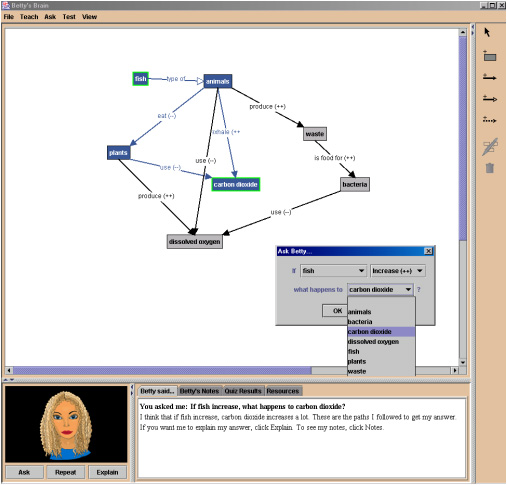
BIOGRAPHY
Kristen Pilner Blair is a PhD student in the Learning Sciences and Technology Design program at Stanford University's School of Education. Her research focuses on creating technology for math and science education. She works on the Teachable Agents project, and she has designed agents for helping students learn fractions and statistics. She is interested in the potential of combining Teachable Agent technology with video game environments to create motivating learning environments that combine many types of instructional resources.
ABSTRACT
Guided Discovery Games with Teachable Agents
Individual Presentation, Friday (9:00 - 10:30) in
Hall of Ideas F
We present an educational video game that brings our work on Teachable Agents (TAs) into a 3-D game environment (the Torque engine). TAs are programs that students teach to answer questions and solve problems. We did not put TAs into a 3D-game to increase motivation (TAs alone are quite motivating.) Instead, the game world increases the ways we can provide learning resources, including domain simulations, metacognitive support, self-assessments, and guided discovery.
TAs capitalize on the adage that one learns best by teaching. Students teach the TA content knowledge and assess its knowledge by asking questions. Based on the answers, students can revise their agent's knowledge (and their own). With the TA Betty, students teach by creating her concept map. Betty answers questions using artificial intelligence techniques and animates her reasoning in the concept map. Multiple studies have shown the pedagogical value of Betty. In the current work, we have embedded Betty in a simulation. One benefit is that Betty can take actions in the virtual world, and students can see if their teaching yields good results.
 The game we have been developing helps students learn about plant
growth in the context of a pumpkin festival. Students teach Betty how
to grow giant pumpkins to earn money for her family. Both the
student (represented as an embodied avatar) and Betty (represented as
an embodied agent) can take actions in the virtual world. Students
are responsible for both their own actions and Betty's performance.
Students must make their knowledge explicit by teaching Betty. At
the same time, Betty makes her reasoning explicit by animating her
concept map. Thus, unlike many simulations, where the "code" that
controls an agent or environment is hidden from view, Betty makes her
knowledge visible.
The game we have been developing helps students learn about plant
growth in the context of a pumpkin festival. Students teach Betty how
to grow giant pumpkins to earn money for her family. Both the
student (represented as an embodied avatar) and Betty (represented as
an embodied agent) can take actions in the virtual world. Students
are responsible for both their own actions and Betty's performance.
Students must make their knowledge explicit by teaching Betty. At
the same time, Betty makes her reasoning explicit by animating her
concept map. Thus, unlike many simulations, where the "code" that
controls an agent or environment is hidden from view, Betty makes her
knowledge visible.
The game context permits several forms of learning resources:
(1) Carnival booths where the student and Betty can play games, such
as conducting an experiment and guessing the outcome. These short
interactions provide domain information, and students get immediate
feedback.
(2) Wandering characters who provide metacognitive tips and domain
knowledge. When Betty encounters another character, she can merge
concept maps with that character. However, characters can have bad
concept maps, and students must evaluate the character's concept map
to determine if Betty should merge.
(3) A pumpkin growth simulation. Betty can enter a pumpkin contest.
The quality of the final pumpkin is determined by the actions she
chooses based on her concept map.
(4) A guided discovery game (GDG). Based on Betty's knowledge (the
nodes and links in Betty's concept map) the GDG can change features
of the world, for example, by opening and closing booths, sending
characters to talk to the student, or changing the simulation to
highlight important variables (e.g. changing the amount of rain).
In sum, we have created a template for GDG's that use TAs. The learner's goal is not to develop perceptual-motor skills to destroy a foe, but rather, to develop explicit knowledge that can help their agent solve educationally relevant challenges.